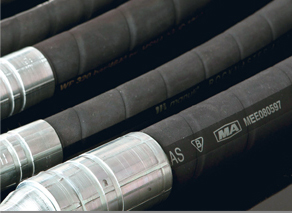Professional Manufacturer for Hydraulic Hose Assembly
Introducing HYDRAULIC HOSE products.




Select the specified hoses, ferrules and inserts
using the most updated Catalogue release
Cut squarely the hose (cut angle must be ≤ 3).
In order to ensure a correct cut (minimum
rosetting and tulip effect due to the heat
damage to the rubber), it is recommended
to use the appropriate blade type
| · | wire spiral, large bore wire braided (> DN31) & Spirtex: use a smooth blade. |
|---|---|
| · | wire braided small bore (≤ DN31) : use a serrated blade Use of scalloped blade (with wavy edge) is acceptable for all hose types |
When skiving is required, set-up the skiving
machine such that the front edge of the knife
is set to the correct length (refer to
crimping
chart: tolerance +/-0.5 mm; +/0.02 inch).
It is important to remove the maximum
thickness of the rubber hose cover
without
damaging or displacing the reinforcement
steel wires.
| · | In case of two-piece fittings, mount the ferrule fully onto the hose, and then push the insert fully into the hose. |
|---|---|
| · | In case of one-piece fittings, mark the hose insertion depth (distance from the bottom of the ferrule to its end to be measured by calipers) on the hose cover and push the coupling fully into the hose up to the mark made on the hose cover. Especially in case of large hose sizes and lock type fittings the use of a proper pushing machine is recommended to facilitate this operation |
Choose the die-set closest to and smaller
than the specified Crimping Diameter
– 0.4 mm.
The 0.4 mm correction is
necessary to assure the requested
crimping diameter, allowing some ferrule
bulging among the dies, when
crimping
close to the dies closure diameter.
Examples
| · | For achieving a finished crimping diameter of 23.5 mm choose the die-set marked 21 as it is closest to and smaller than 23.5-0.4=23.1). |
|---|---|
| · | For achieving a finished crimping diameter of 24.1 mm don’t use the die-set marked 24 but use the dies set marked 21 as it is closest to and smaller than 24.1-0.4=23.7). |